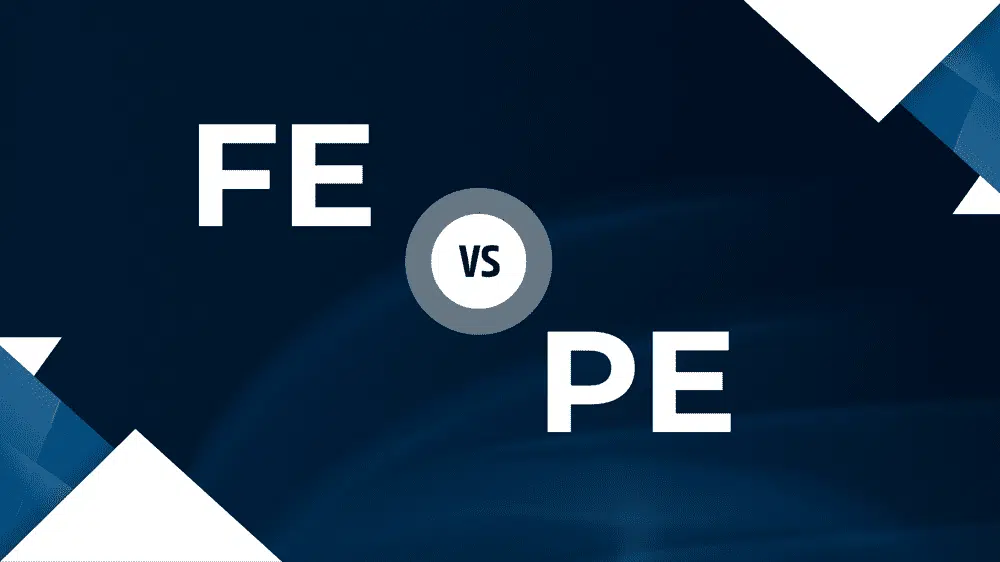If you are an engineering graduate in the USA who is interested in growing their engineering career, then the FE and PE exams must be on your mind. You should know the difference between these two exams, their costs, the process of applying and passing them, their difficulty levels, etc.
In today’s article, I will explain the FE and PE exams and answer your common questions so you can better understand the process of becoming a licensed professional engineer.
Both exams are conducted by the National Council of Examiners for Engineering and Surveying (NCEES) in the United States. NCEES is a non-profit organization dedicated to advancing professional licensure for engineers and surveyors. They work with state licensing boards to develop and administer these exams and ensure consistency and high standards in the licensure process.
Individual state licensing boards can have specific requirements and procedures. Therefore, you must familiarize yourself with the regulations and guidelines defined by NCEES and your state licensing board.
What is the FE Exam?
To become a licensed professional engineer in the United States, you must pass the Fundamentals of Engineering (FE) exam. The FE exam has 110 questions on all branches of engineering and is divided into two sessions (morning and afternoon), with 55 questions each.
The exam lasts six hours and is conducted in a controlled, computerized environment. The Pearson VUE conducts the test, and you cannot bring any notes or books inside the test room, though you can use a calculator.
After passing the FE exam, you will receive the Engineering in Training (EIT) title. After earning four years of experience, you can apply for the PE exam.
What is the PE Exam?
To become a licensed professional engineer, you must pass the Principles and Practice of Engineering (PE) exam. The PE exam has 80 to 85 questions, depending on your engineering discipline. Civil, mechanical, chemical, power, and environment engineering have 80 questions, and others have 85.
This exam is also conducted in a controlled computerized environment.
Passing the PE exam is vital, as all states’ Board of Engineers require practicing engineers to do so. This certification validates your knowledge, skills, and experience, and it is valued by industries. Passing this exam gives you some legal benefits (e.g., signing and sealing stamps).
Both exams are closed books, but you can access the electronic version of the NCEES reference handbook during the exam.
Difference Between the FE and PE Exams
The FE and PE exams are required at different stages of your career growth. You can take the FE exam after passing your graduate exam. Afterward, once you earn four years of experience in the engineering profession, you can attempt the PE exam, and once you pass it, you will become a licensed professional engineer.
The FE exam tests your knowledge of the course you have studied, and the PE exam tests your educational knowledge and real-world experience in the engineering profession.
The professionals who took both tests reported that the PE exam was tougher than the FE exam. Because of the difficulty level, the passing rate of the FE exam is higher than that of the PE exam. The FE exam’s passing rate for first-time exam takers is 71%, while the PE exam’s first-time pass rate in all engineering disciplines is 65%.
Exam Fees for the FE and PE Exams
The FE and PE exam fees are 225 USD, and 400 USD is paid directly to the National Council of Examiners for Engineering and Surveying (NCEES).
This fee does not include the cost of books and other study resources required to prepare for the exams.
How to Apply for the FE and PE Exams
You can apply for the FE exam anytime, as the registration is open year-round. You can apply for the PE exam two months before the exam date.
You can attempt the FE exam at a Pearson VUE center. You can try the exam three times in any year. You can try the PE exam two times a year, in April and October.
Passing Scores for the FE and PE Exams
You either pass or fail the FE exam, and there is no ranking or grading system. There is no universal passing score for the FE exam, as it depends on the questions you receive on your specific FE exam.
The PE exam’s passing score is 70%, meaning you will need to answer 56 questions correctly out of 80.
How to Study for the FE and PE Exams
You must refer to the PE exam reference book and other FE courses to pass the FE exam. Passing the FE exam is easy; one to two months of preparation is enough.
Passing the PE exam is tougher; you must study for at least three to four months. You must study the PE exam reference book for the PE exam preparation and can join some PE exam preparation courses.
Passing the FE and PE exams is vital for your career growth and becoming a professional engineer in the USA. You must take these examinations seriously and prepare well to pass them on your first attempt.
Frequently Asked Questions for the FE and PE Exams
Q1. Who should take the FE exam?
The FE exam is taken by engineering students or recent graduates who wish to become licensed professional engineers. You can take this exam during the final year of undergraduate studies or after graduation.
Q2. Who should take the PE exam?
The PE exam is for engineers who have gained several years of work experience and want to become licensed professional engineers. It is taken after fulfilling the experience requirement.
Q3. What is the format of the FE exam?
The FE exam is a computer-based test consisting of multiple-choice questions. It covers topics in engineering, including mathematics, probability and statistics, ethics, engineering economics, and specific engineering disciplines.
Q4. What is the format of the PE exam?
The PE exam is discipline-specific and is offered in various engineering disciplines, such as civil, mechanical, electrical, and chemical engineering. It consists of two parts: the morning session, which contains multiple-choice questions, and the afternoon session, which includes essay or scenario-based problems.
Q5. Can I take the PE exam without passing the FE exam?
In most cases, passing the FE exam is a requirement for taking the PE exam. However, some states may have alternative pathways for experienced engineers to become licensed without passing the FE exam. Please check with your home state.
Q6. What are the benefits of becoming a licensed professional engineer?
Becoming a licensed professional engineer offers several advantages, including increased job opportunities, earning potential, enhanced professional credibility, and the ability to take on leadership roles in engineering projects.
Q7. How often are the FE and PE exams offered?
The FE exam is typically offered year-round at approved testing centers. The PE exam is usually offered twice a year, in April and October, although the exact schedule may vary depending on the engineering discipline and state licensing board.
Q8. How long will the FE and PE exam scores be valid?
FE exam scores are valid for an extended period, often 2 to 5 years, depending on the licensing board’s policies. PE exam scores may also have expiration dates, usually 3 to 5 years, but this can vary by state.
Q9. What if I fail the FE or PE exam?
If you fail the FE or PE exam, you can usually retake it after a waiting period determined by the licensing board.
Q10. Can I take the FE or PE exam in a different discipline from my academic or professional background?
You can take the FE or PE exam in a different discipline, but you must meet eligibility requirements set by the licensing board. Before registering for the exam in a different discipline, you must check with the board regarding any restrictions.
Q11. Can I take a break during the FE or PE exam?
You can have a break in both exams. The break duration is 25 minutes for the FE exam and 50 minutes for the PE exam.
Summary
The FE and PE exams do not compete with each other; instead, they complement each other. To become a professional engineer in the United States, you must pass the FE exam after completing an engineering graduate course. You can attempt the PE exam once you earn four years of experience in your field.

I am Mohammad Fahad Usmani, B.E. PMP, PMI-RMP. I have been blogging on project management topics since 2011. To date, thousands of professionals have passed the PMP exam using my resources.







